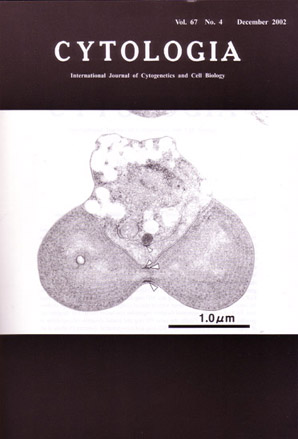| ON THE COVER |  |
|---|---|
| Vol. 67 No.4 December 2002 | |
| Technical note and concept | |
|
|
|
| Plastids and mitochondria are divided basically by very similar or same
mechanism Mitochondria and plastids contain distinct genomes and multiply by binary and multiply division of preexisting organelles. The FtsZ rings appear in chloroplast stroma and mitochondrial matrix before the formation of plastid-dividing (PD) ring and mitochondrion-dividing (MD) ring and face the inner PD ring (Miyagishima et al. 2001 Plant Cell 13, 1; Kuroiwa et al. 2002 Planta215, 185) and the inner MD ring at the far side from the inner envelope (Takahara et al. 2001 Cytologia 66,421). After the formation of the inner PD ring, thc middle and outer PD rings (large arrowheads in Figure) and outer MD ring (small arrowheads in Figure) form in cytosolic face of the outer envelope before organelle division and constrictions start (Miyagishima et al. 2001 Plant Cell l3,1). The FtsZ and inner (and middle) PD ring and MD ring decompose and they contract, whereas the outer PD and MD ring contract without loss of components. At the late stage of division, the FtsZ rings are separated daughter organelles just before the split of daughter organelles and disappear. Finally, the outer PD ring and plastid dynamin (Miyagishima et al. unpublished data ) and the outer MD ring and mitochondrial dynamin (Nishida et al. 2002 in Proc. The 66th. Ann. Meet. Bot. Soc. Japan, ppl67, 31F09) pinch off the plastid and mitochondrion, respectively. We conclude on these results that plastids and mitochondria are divided basically by very similar or same mechanism. (Tsuneyoshi Kuroiwa, Haruko Kuroiwa, Keizo Nishida and Shin-ya Miyagishim, Department of Biologlcal Sciences, Graduate School of Science, Univrersity of Tokyo 113-0033, Japan) |
|